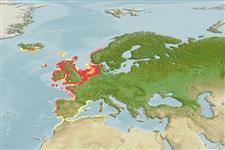Common names from other countries
Environment: milieu / climate zone / depth range / distribution range
Écologie
; profondeur 0 - 60 m (Ref. 106944). Subtropical, preferred 10°C (Ref. 107945); 65°N - 32°N, 24°W - 12°E
Eastern Atlantic and the Mediterranean: From southern Iceland to North Sea, Morocco and Madeira to the Mediterranean.
Length at first maturity / Taille / Poids / Âge
Maturity: Lm ? range ? - ? cm Max length : 5.0 cm SHL mâle / non sexé; (Ref. 7882); âge max. reporté: 13 années (Ref. 106244)
Depth based on occurrence (Ref. 2758, p. 805); to be replaced with better reference. Minimum depth from Ref. 2703. Species' maximum length from the Belgian part of the North Sea (Ref. 7882). Found along the coasts and further out into the open sea, mainly on top of sea banks. Shallowly burrows in coarse-grained sediment. A suspension feeder (Ref. 7882).
Life cycle and mating behavior
Maturité | Reproduction | Frai | Œufs | Fécondité | Larves
Members of the class Bivalvia are mostly gonochoric, some are protandric hermaphrodites. Life cycle: Embryos develop into free-swimming trocophore larvae, succeeded by the bivalve veliger, resembling a miniature clam.
Gaspar, M.B., M.N. Santos and P. Vasconcelos. 2001. (Ref. 2758)
Statut dans la liste rouge de l'IUCN (Ref. 130435)
statut CITES (Ref. 108899)
Not Evaluated
Not Evaluated
Utilisations par l'homme
Pêcheries: commercial
FAO - pêcheries: landings | FishSource | Sea Around Us
Outils
Sources Internet
Estimates based on models
Preferred temperature
(Ref.
115969): 8.6 - 12.5, mean 10.4 (based on 344 cells).
Résilience
Haut, temps minimum de doublement de population inférieur à 15 mois (K=0.23-0.43; tm=1; tmax=13).
Vulnérabilité
Low vulnerability (10 of 100).
